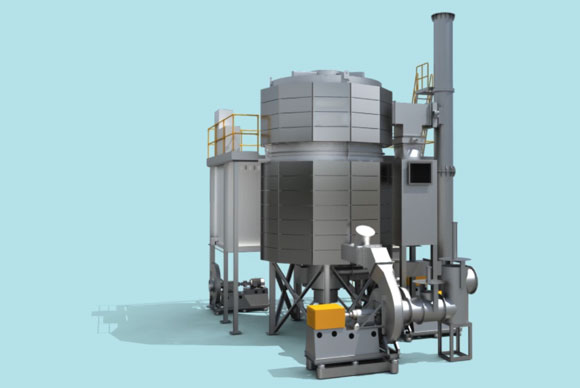How efficient is a regenerative thermal oxidizer?
вступ
A regenerative thermal oxidizer (RTO) is an advanced air pollution control system that is widely used in industrial applications. It is designed to effectively destroy harmful pollutants emitted during various manufacturing processes. The efficiency of an RTO is a crucial factor in determining its effectiveness in reducing emissions and meeting environmental regulations.
Operating Principle
An RTO works based on the principle of thermal oxidation, where pollutants are oxidized at high temperatures. The system utilizes a regenerative process to achieve high energy efficiency. It consists of multiple ceramic beds filled with heat-absorbing media, such as ceramic balls or structured ceramic blocks.
The operation of an RTO involves the following steps:
- Hot exhaust gases containing pollutants enter the oxidizer.
- The gases pass through one ceramic bed, transferring heat to the media.
- The preheated gases then enter the combustion chamber, where they are brought to the ignition temperature.
- Once ignited, the gases are oxidized, breaking down the pollutants into harmless byproducts.
- The clean, hot gases leave the combustion chamber and pass through another ceramic bed, transferring heat to the media.
- The media in the first bed that absorbed heat during the previous cycle is now used to preheat the incoming gases.
Factors Affecting Efficiency
The efficiency of an RTO is influenced by several factors:
- Temperature: Higher temperatures generally lead to better pollutant destruction efficiency. However, excessively high temperatures may result in thermal stress and increased energy consumption.
- Retention Time: Sufficient residence time is necessary for complete oxidation of pollutants. The design of the RTO ensures an adequate duration for the gases to pass through the system, allowing for efficient pollutant destruction.
- Heat Recovery: The regenerative process enables heat recovery, significantly improving energy efficiency. The media in the ceramic beds absorb and store heat, which is then utilized to preheat the incoming gases, reducing the energy required for combustion.
- Control System: The effectiveness of the control system in monitoring and adjusting parameters, such as temperature and airflow, contributes to the overall efficiency of the RTO.
Advantages of High Efficiency
A highly efficient RTO offers several benefits:
- Reduced Operating Costs: High energy efficiency results in lower fuel consumption and decreased operational expenses.
- Compliance with Regulations: Meeting emission limits and environmental regulations is crucial for industrial facilities. A more efficient RTO ensures effective pollutant destruction, helping companies stay in compliance.
- Environmental Impact: By efficiently destroying pollutants, RTOs help protect air quality and minimize the release of harmful substances into the atmosphere.
Висновок
In conclusion, a regenerative thermal oxidizer is a highly efficient air pollution control system that utilizes a regenerative process to achieve effective pollutant destruction. Factors such as temperature, retention time, heat recovery, and control system play crucial roles in determining the efficiency of an RTO. High efficiency brings various advantages, including reduced operating costs and compliance with environmental regulations. Implementing an efficient RTO can contribute to a cleaner and more sustainable industrial environment.

Представлення компанії
We are a high-tech manufacturing company specializing in comprehensive treatment of volatile organic compound (VOC) exhaust gas and carbon reduction energy-saving technology. Our core technologies include thermal energy, combustion, sealing, and automatic control. We have the capabilities for temperature field simulation, air flow field simulation modeling, ceramic heat storage material performance, molecular sieve adsorption material selection, and VOC high-temperature incineration oxidation characteristics testing.
Переваги команди
We have an RTO technology R&D center and exhaust gas carbon reduction engineering technology center in Xi’an, as well as a 30,000m2 production base in Yangling. We are a leading manufacturer of RTO equipment and molecular sieve rotary wheel equipment globally. Our core technical team comes from the Aerospace Liquid Rocket Engine Research Institute (Aerospace Sixth Academy). We currently have more than 360 employees, including over 60 R&D technical backbones, including 3 senior engineers at the researcher level, 6 senior engineers, and 48 thermodynamics doctors.
Основні продукти
Our core products include the Rotary Valve Regenerative Thermal Oxidizer (RTO) and molecular sieve adsorption concentration rotary wheel. Combined with our expertise in environmental protection and thermal energy system engineering, we can provide customers with comprehensive solutions for industrial exhaust gas treatment, carbon reduction, and thermal energy utilization under various operating conditions.

Сертифікати, патенти та відзнаки
- Сертифікація системи управління інтелектуальною власністю
- Сертифікація системи управління якістю
- Сертифікація системи екологічного менеджменту
- Кваліфікація підприємства будівельної індустрії
- Високотехнологічне підприємство
- Patent for Rotary Valve Регенеративний термічний окислювач
- Patent for Rotary Heat Storage Incineration Equipment
- Патент на роторне колесо дискового молекулярного сита
Вибір правильного обладнання RTO
When selecting suitable RTO equipment, consider the following factors:
- Exhaust Gas Volume and Composition: Analyze the volume and composition of the exhaust gas to determine the appropriate capacity and treatment efficiency.
- Thermal Efficiency: Evaluate the thermal efficiency of the RTO equipment to ensure optimal energy utilization.
- Operating Temperature Range: Consider the operational temperature range required for efficient VOC oxidation.
- System Control and Monitoring: Assess the control and monitoring capabilities to ensure reliable and stable operation.

Процес обслуговування
Our service process includes the following steps:
- Consultation and Evaluation: Initial consultation, on-site inspection, and needs analysis.
- Design and Solution Development: Solution design, simulation modeling, and solution review.
- Production and Manufacturing: Customized production, quality control, and factory testing.
- Installation and Commissioning: On-site installation, commissioning, and training services.
- After-sales Support: Regular maintenance, technical support, and spare parts supply.
We provide one-stop solutions and have a professional team to tailor RTO solutions for our clients. Each step of the process is explained in detail to ensure customer satisfaction.
Автор: Мія
